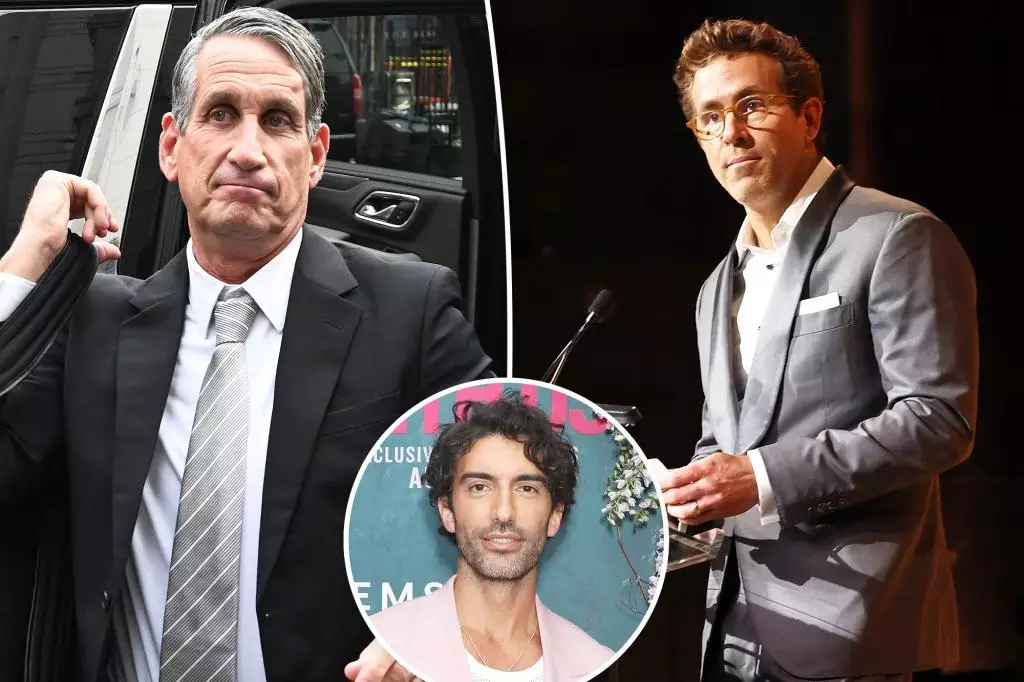The world of Hollywood is no stranger to scandal, yet the recent legal battle involving Justin Baldoni, Ryan Reynolds, and Blake Lively offers a vivid illustration of how personal grievances can escalate into high-stakes courtroom confrontations. At the heart of this conflict is a staggering $400 million defamation and extortion lawsuit filed by Baldoni against Reynolds, Lively, and their publicist. This dispute not only highlights the frailty of reputations in Tinseltown but also raises poignant questions about the implications of speech, trust, and personal integrity in a public arena ready to sensationalize every misstep.
Bryan Freedman, Baldoni’s attorney, paints Reynolds as a central figure in what he describes as a campaign to undermine Baldoni. According to Freedman, Reynolds is “running from the flames,” suggesting that he cannot escape the consequences of his actions, allegedly marked by public and personal denigration of Baldoni. These fiery accusations paint a picture of Reynolds not merely as a supportive spouse but as a manipulative player in a complicated web of allegations surrounding sexual misconduct. The gravity of such statements should not be understated. They portray a man whose public persona of kindness is starkly contrasted by serious allegations made in a court filing.
The Complications of Public Perception
The legal maneuvering has become a spectacle, captivating media attention by revealing how easily public figures can become embroiled in sticky situations that can impact their careers and personal lives for years. Reynolds’ legal team argues that Baldoni’s claims lack substantive legal merit. They frame Reynolds as an individual exercising his First Amendment rights, asserting that calling someone a “predator” hinges on belief and opinion, not defamatory intent. This defense raises a crucial issue: where does personal opinion end, and harmful accusations begin? In a social climate increasingly attuned to the nuances of consent and behavior, such discussions take on heightened significance.
Moreover, the complexities expand when considering Lively’s accusations against Baldoni, which assert that he engaged in sexual harassment during the production of “It Ends With Us.” The possible intersection of these cases emphasizes the difficulty of delineating between actionable defamation and protected speech. If Lively’s allegations hold weight and lead to legal consequences, they could bolster Reynolds’ position while simultaneously eroding Baldoni’s public image. Hollywood thrives on narratives, and this case fits a narrative of victimhood and aggression, challenging audiences to take sides.
Analysis of Legal Strategies and Cultural Implications
As we delve deeper into the legal strategies employed, it’s clear that Baldoni’s approach of targeting prominent figures in Hollywood signals a strategic use of clout and gravitas—designing a lawsuit with the potential to shake the industry. However, in doing so, he risks being viewed as a litigious celebrity rather than a victim of harassment. Baldoni’s claim that Reynolds pressed a talent agency to sever ties with him further complicates the narrative, emphasizing how tightly entwined their careers are.
Reynolds’ attorneys counter by discrediting Baldoni’s narrative, asserting that the allegations stem from personal grudges rather than factual misconduct, showcasing an effective reminder of the tactics celebrity lawyers employ to shift blame and public sympathy. Free speech embroils itself in the undertones of defamation cases, twisting definitions of accountability amidst cultural pressures where the voices of victims must be both heard and critically examined.
The backdrop of this legal mic-drop extends into the broader landscape of Hollywood, where allegations of misconduct are often dissected against a framework of public sentiment and social responsibility. As the legal proceedings escalate, the cultural zeitgeist remains concerned with how public figures manage their personas and what they signify to a larger audience grappling with issues of trust, respect, and reputational damage.
Remaining Resilient in the Heat of Controversy
The courtroom drama finds its roots in deep-seated issues that extend beyond the individual characters involved. Aldoni’s bold legal actions challenge Reynolds and Lively while aiming to reclaim dignity in an industry known for its harsh judgment and fleeting loyalty. However, with every groundbreaking lawsuit, the stakes become profoundly personal and public, leading us to ponder not only the outcomes of these specific claims but also the long-term ramifications on those who wield power, authority, and influence.
As we await the trial set for March 2026, the collisions of personal lives and public personas serve as a stark reminder of the fragile nature of celebrity status. This legal battle is not just about who wins or loses; it’s also about the narratives constructed around them and how they are perceived in a world where the truth is often blurred by sensationalism and public opinion.

